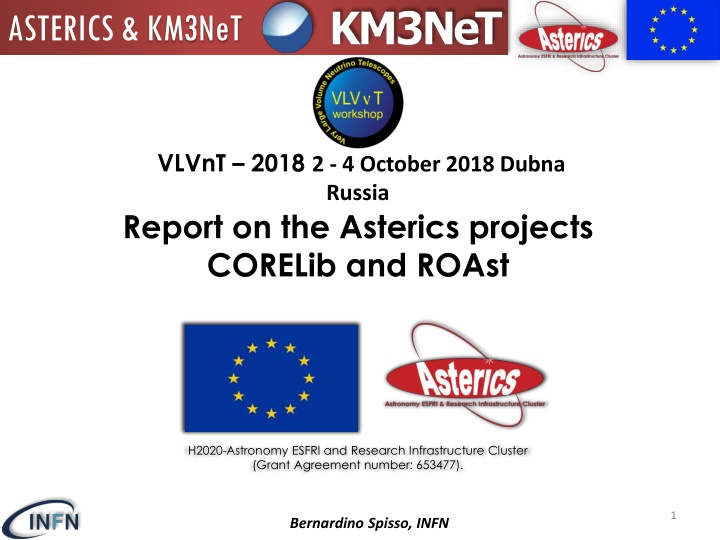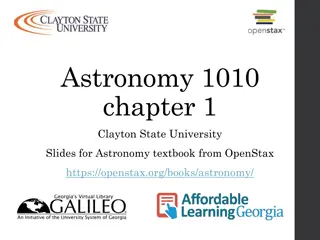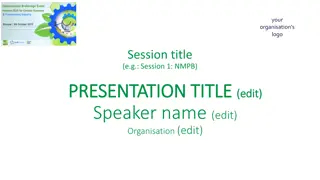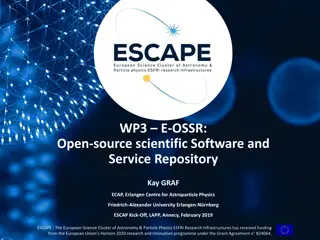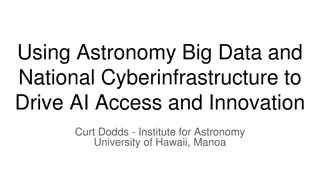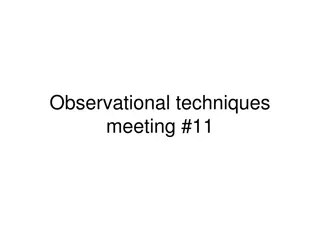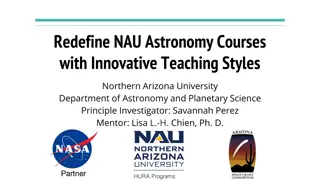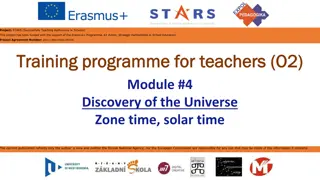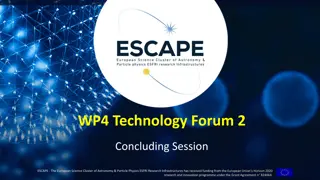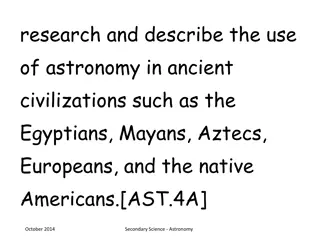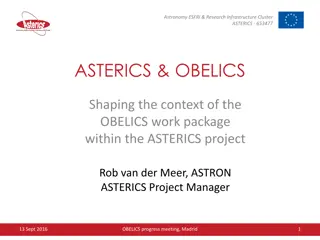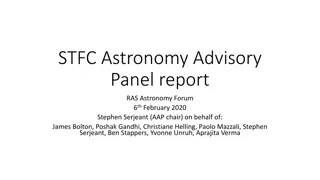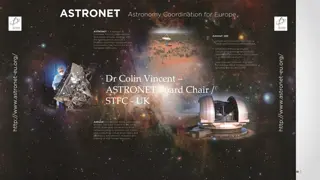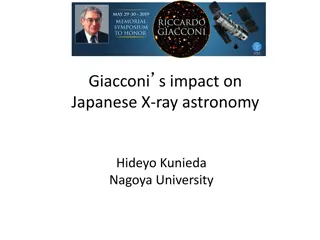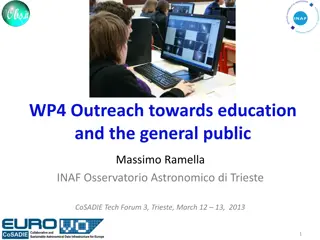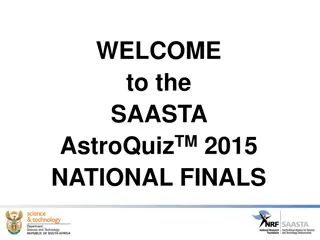Report on ASTERICS Projects CORELib and ROAst H2020-Astronomy ESFRI
This report highlights the ASTERICS projects CORELib and ROAst within the H2020-Astronomy ESFRI program, focusing on data sharing, interoperability, and technological developments to enhance astronomical research capabilities. It discusses the contributions of participating researchers and provides insights into the CORELib's Cosmic Ray Event Library and ROAst's Root extension for Astronomy. The report also emphasizes the importance of collaborative work packages and the utilization of common technologies to benefit the astronomy community.
Download Presentation

Please find below an Image/Link to download the presentation.
The content on the website is provided AS IS for your information and personal use only. It may not be sold, licensed, or shared on other websites without obtaining consent from the author.If you encounter any issues during the download, it is possible that the publisher has removed the file from their server.
You are allowed to download the files provided on this website for personal or commercial use, subject to the condition that they are used lawfully. All files are the property of their respective owners.
The content on the website is provided AS IS for your information and personal use only. It may not be sold, licensed, or shared on other websites without obtaining consent from the author.
E N D
Presentation Transcript
ASTERICS & KM3NeT VLVnT 2018 2 - 4 October 2018 Dubna Russia Report on the Asterics projects CORELib and ROAst H2020-Astronomy ESFRI and Research Infrastructure Cluster (Grant Agreement number: 653477). 1 Bernardino Spisso, INFN
ASTERICS & KM3NeT ASTERICS: Astronomy ESFRI and Research Infrastructure Cluster In Horizon2020 programme Brings together SKA, CTA, ELT, KM3NeT Web site: http://www.asterics2020.eu Core work package: WP 3 OBELICS (OBservatory E-environments LInked by common ChallengeS) Data sharing and interoperability work package: WP 4 DADI (Data Access, Discovery and Interoperability ) Timing work package: WP 5 CLEOPATRA (Connecting Locations of ESFRI Observatories and Partners in Astronomy for Timing and Real-time Alerts) Share, develop and co-develop common technologies that may turn useful both to existing ESFRI s and to their upgrades (or future ones) to correlate and leverage shared knowledge Make software and data usable also outside of the original environment in which they were generated/conceived Bernardino Spisso, INFN-VLVnT 2018 2
ASTERICS & KM3NeT INFN and KM3NeT in ASTERICS (OBELICS) CORELib: COsmic Ray Event Library work within the KM3NeT CORSIKA WG (P. Mijakowski) Based on CORSIKA, but output must be CORSIKA-independent Main contributions: High statistics common production common set of parameters A common framework and tool to produce manage large productions Contributors: Simona Maria Stellacci Bernardino Spisso Carmelo Pellegrino ROASt: ROot extension for Astronomy mostly with KM3NeT Computing WG (K. Graf) ROOT is the de facto standard for high-energy physics but it lacks packages and tools for astrophysical research Main contributions: Add astronomical catalogs Add astrophysical tools Contributor: Bernardino Spisso 3 Bernardino Spisso, INFN-VLVnT 2018
ASTERICS & KM3NeT CORELib CORELib: COsmic Ray Event Library Background to many experiments Also a tuning benchmark Potentially useful to other communities Currently using CORSIKA as generator Status of production Proton-induced showers (1 delivery production): o HE models: QGSJET01 with CHARM, QGSJET01 with TAULEP, QGSJET-II with TAULEP, EPOSLHC with TAULEP o LE model: GHEISHA o about 21M Evts per HE model o 7 energy bins (2 102GeV-103GeV+equally logarithmically spaced from 1TeV to 109GeV) o power-law spectrum with -2 spectral index o zenith angle from 0 to 89 degrees Nuclei (Fe He CNO ) induced showers: o HE models: QGSJET01 with CHARM, QGSJET01 with TAULEP, QGSJET-II with TAULEP, EPOS-LHC with TAULEP o LE model: GHEISHA o about 21M Evts per HE model o 7 energy bins (A 2 102GeV-A 103GeV+equally logarithmically spaced from A 1TeV to A 109GeV) o power-law spectrum with -2 spectral index o zenith angle from 0 to 89 degrees CORELib can be downloaded via SFTP at corelib@193.205.188.227 pwd = Asterics2020 Bernardino Spisso, INFN-VLVnT 2018 4
ASTERICS & KM3NeT CORELib CORELib: COsmic Ray Event Library Status of production Energy range (GeV) 200-1000 103-104 104-105 105-106 106-107 107-108 108-109 Production done with and without Cherenkov radiation Number of events 107 107 106 105 104 103 102 QGSJET01 High energy model Low energy model Option TAULEP CHARM GHEISHA X QGSJET01 GHEISHA X About 21M events per HE model QGSJETII-04 GHEISHA X EPOS LHC GHEISHA X 5 Bernardino Spisso, INFN-VLVnT 2018
ASTERICS & KM3NeT Ongoing production Proton-induced showers: - New production is on going using flat spectrum. - Sea level as observation level and the standard European atmosphere. - HEMODELS: QGSJET01 with CHARM, QGSJET01 with TAULEP, QGSJET-II with TAULEP, EPOSLHC with TAULEP - LEMODEL: GHEISHA. - about 15M Evts per HE model. 7 energy bins (2 102GeV-103GeV+equally logarithmically spaced from 1TeV to 109GeV). - - Flat power-law spectrum with 0 spectral index. - zenith angle from 0 to 89 degrees . 3.000.000 hi-energy events ( 107-109GeV) Vs. 1.100 of the previous productions. - 90 % Complete: only EPOS 107-109GeV energy range left and on going. - 6 Bernardino Spisso, INFN-VLVnT 2018
ASTERICS & KM3NeT The details for each run for the first two productions are collected in SQLite data base which can be exported in an Excel compatible spreadsheet. 7 Bernardino Spisso, INFN-VLVnT 2018
ASTERICS & KM3NeT Ongoing support production From binary CORSIKA output files, containing the cosmic ray induced showers, is on going a conversion in to the ASCII evt format. Distinct files for Hadrons, E.M., Muons and Neutrinos. The evt files are generated using CORANT ( conversion tool developed by T.Chiarusi, L.A. Fusco, C. Pellegrino and modified ad hoc by B. Spisso and S.M. Stellacci) -> Many thanks to Carmelo for the help. 8 Bernardino Spisso, INFN-VLVnT 2018
ASTERICS & KM3NeT ROAst ROAst: ROot extension for Astronomy ROOT is the de facto standard for high-energy physics but it lacks packages and tools for astrophysical research. Indeed, the main aim of ROAst is to add native classes to access astronomical catalogues and general astrophysical tools in order to bridge the two worlds. ROAst sky-map is available on GitLab! - Two local test catalogues are used: the UCAC4 (U.S. Observatory CCD Astrograph Catalog 4) and the URAT1; high accuracy positional catalogues integrating some extra information as proper motions and double star flag. - Supports the on-line Virtual Observatory (VO) catalogues and VizieR catalogue repository. - It features Graphic support library which rely on the ROOT graphic tools, all the ROOT graphical options are integrated. - It features Moon and Sun position. - It uses an intermediate abstraction layer in order to speed-up the next catalogues implementations. - Supports equatorial, galactic, ecliptic, horizontal astronomical coordinates (using Lat-Long and UTM as geographical coordinates) and allows coordinate transformations. - Current improved version thanks to Aart Heijboer's suggestions. 9 Bernardino Spisso, INFN-VLVnT 2018
ASTERICS & KM3NeT The VizieR Catalogue Service VizieR features 17621 catalogues available from CDS of which 16999 are available on- line, some examples are: Fermi/LAT Planck Catalog ROSAT etc The Virtual Observatory The Virtual Observatory is an international astronomical community-based initiative. It aims to allow global electronic access to the available astronomical data archives of space and ground- based observatories and other sky survey databases. Some examples of VO institutions are: Euro-VO: the European VO (a partnership of VOs including AstroGrid, ESO, ESA...). The Mikulski Archive for Space Telescopes (MAST): a NASA funded project. The German Astrophysical Virtual Observatory (GAVO). VAO: the US Virtual Astronomical Observatory. IVOA: the International Virtual Observatory Alliance. 10 Bernardino Spisso, INFN-VLVnT 2018
ASTERICS & KM3NeT TROAstCatalogue class The astronomical objects can be extracted projecting the catalogue to three different geometrical regions and using different coordinate system: ExtractObjectsRectangle Equatorial/Galactic coordinates Horizontal coordinates ExtractObjects ExtractObjectsCircle Equatorial/Galactic coordinates Horizontal coordinates ExtractObjectsEllipse Equatorial/Galactic coordinates Horizontal coordinates The extracted astronomical objects are stored in the public vector ObjectsColletion and can be displayed using the Print method. 11 Bernardino Spisso, INFN-VLVnT 2018
ASTERICS & KM3NeT TROAstConversions class This class contains all the coordinate and time conversion methods which are catalogue independent. The main methods are: LL2UTM //Converts Lat-Long geographical coordinates to UTM coordinates. UTM2LL //Converts UTM geographical coordinates to Lat-Long coordinates. UTC2UnixTime //Converts UTC to Unix time. UnixTime2UTC //Converts Unix time to UTC. Equatorial2Horizontal //Converts equatorial coordinates to horizontal ones. Horizontal2Equatorial //Converts horizontal coordinates to equatorial ones. Equatorial2Galactic //Converts equatorial coordinates to galactic ones. Galactic2Equatorial //Converts galactic coordinates to equatorial ones. Equatorial2Ecliptic //Converts equatorial coordinates to ecliptic ones. Ecliptic2Equatorial //Converts ecliptic coordinates to equatorial ones. 12 Bernardino Spisso, INFN-VLVnT 2018
ASTERICS & KM3NeT Coordinate conversions tested using existing ANTARES benchmarks 13 Bernardino Spisso, INFN-VLVnT 2018
ASTERICS & KM3NeT TROAstGraphics class The aim is to supply a basic set of graphical tools fully coherent with the ROOT environment. The customization of the plot is left to the user. The main methods are: Draw //Draws the astronomical objects positions. DrawFeature //Draws the selected feature of the astronomical objects. DrawAitoff //Draws the astronomical objects using equatorial Aitoff projection. DrawSkyMap //Draws the whole sky-map using equatorial Aitoff projection. Draw and DrawFeature methods support equatorial/galactic/horizontal astronomical coordinate system. A way to use decreasing RA axis in the graphs is implemented setting true a global variable. (Thanks to Dorothea Samtleben) 14 Bernardino Spisso, INFN-VLVnT 2018
ASTERICS & KM3NeT A graphical example 15 Bernardino Spisso, INFN-VLVnT 2018
ASTERICS & KM3NeT A graphical example The DrawFeature method can be used to plot a feature. For example, the magnitude can be drawn at fixed wavelength or some special flags. 16 Bernardino Spisso, INFN-VLVnT 2018
ASTERICS & KM3NeT Compilation and support What you need: the optional local catalogues (UCAC4 and URAT1), gcc/g++ version 4.8 (c++11 support) with libcurl library, ROOT 6 (ROAst on ROOT 5 works but without dictionary since rootcint 5 does not support c++11), to set the environment variables for the compilation (root location, local catalogue locations, remote catalogue end-point, ), to run make and/or make TROAstGraphics.so (tested on CentOS 6 and 7). 17 Bernardino Spisso, INFN-VLVnT 2018
ASTERICS & KM3NeT Conclusions and perspectives CORELib Several models used to provide simulations. Common data format using evt files for an immediate usage. Open-access: SFTP with common user/pwd. CORELib provides the full set of parameters, so if other Collaborations or institutions want to add datasets, they can do with/without overlap. A new productions at different observation levels ( 2200 m , 4000 m and more) jointly with other Collaborations (within cooperation agreements to be defined ). CORELib is in the spirit of ASTERICS: a tool needed by KM3NeT, whose features have been extended to prove useful to many people in the community. ROAst An updated and bug fixed version with an improved set of graphical tools is ready and can be found at https://baltig.infn.it/spisso/ROAst and https://gitlab.com/Spisso/ASTERICS-ROAst A full test of supported coordinate transformations was performed. Next: add other support methods for the coordinate manipulations. Next: add methods which returns the positions of the major planets. Next on catalogues: add the supports for the image catalogues. Next on catalogues: add the support for asynchronous on-line query (TAP call). 18 Bernardino Spisso, INFN-VLVnT 2018
ASTERICS & KM3NeT Thank you for the attention. 19 Bernardino Spisso, INFN-VLVnT 2018
